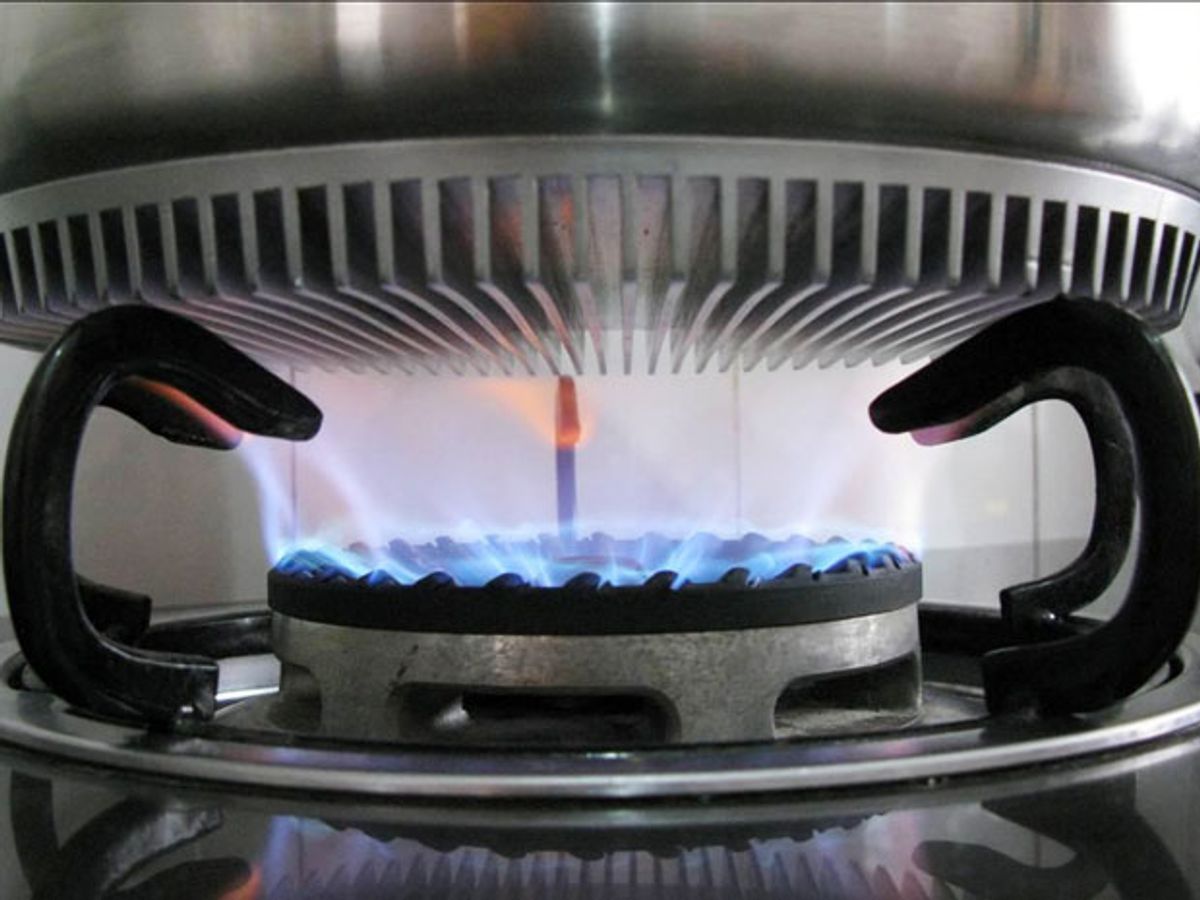In 2007, Lee Huang, a physicist by training, was working in the telecommunications industry, developing laser technology for projection television displays. He was also remodeling his house, and as part of that process went stove shopping. What he found was surprising—though gas ranges are better for cooking tasty food, they aren’t all that energy efficient, with a lot of heat escaping out from underneath the pots and pans placed on the burners.
To Huang, a fix for this seemed obvious—put a heat sink on the bottom of a pot. Inside computers, a heat sink, typically an aluminum base with an array of fins attached, takes heat from a chip and spreads it out so it cools faster. On a pot, Huang thought he could turn that process upside down, use a similar array of fins to take heat from the flame and concentrate it to cook more efficiently.
Huang bought himself a couple of half-inch thick chunks of aluminum and took them to a machine shop. A machinist cut fins on one side of one piece of the aluminum and a small reservoir on the other side; on the other piece, the machinist just carved out the reservoir. Huang took those home and placed them side-by-side on his kitchen stove. He turned on the burners, and put a measured amount of water in each one, and determined that indeed, the plate with the heat sink evaporated the water much faster. The design looked like it would work.
But an aluminum plate isn’t a pot. Huang bought an eight-inch pipe, had another finned heat sink produced, and welded the two together. This was now looking something like a pot. His wife began using it to boil noodles. (Huang explains his design in the video above.)
Huang took his prototype to PG&E’s Food Service Technology Center (FSTC) in San Ramon, Calif. The center is intended to help people in the commercial food industry design more energy efficient operations; FSTC staff tested the prototype and told Huang that he was on to something, but to make it a commercial product he’d need to make a much bigger pot. Researchers at the Technology Center tagged his invention the Turbo Pot.
So Huang bought $25,000 worth of commercial cookware and found one company to manufacture the heat sinks and another company to weld them onto the pots. In the end he had very efficient—but very expensive—pots. He started working with a Chinese manufacturer to develop a better manufacturing process, which they figured out in early 2009. (Huang now has a patent on the manufacturing method; the idea of putting a heat sink on the bottom of a pot, it turns out, was tried about 50 years ago, but was never commercialized.)
Meanwhile, Huang’s day job was looking less interesting—the success of LCD television displays had pretty much killed projection TV for the home. The company he had worked for, Necsel, had gone on to focus on theater projection, and Huang decided to work on his cookware technology full time. He named his company Eneron, and launched his Turbo Pot product at the 2009 National Restaurant Association Show in Chicago. He had a few models of pots, selling at about US $40 to $50 for the smallest, 3.5-quart (3.3-liter) version, a little less than twice as much as a comparable commercial pot. Generally, his pots cost 30 to 50 percent more. He had data from the FSTC that showed his pots cooked at least 30 percent more efficiently than standard pots. Representatives from commercial restaurant chains were interested and one, Carraba’s Italian Grill, placed an order.
Since then, Huang’s business has grown slowly, but he is optimistic. Besides Carraba’s, he’s sold pots to Panda Express and Cheesecake Factory. He says Carraba’s and Panda Express are using his pots to save money, turning down the burners but not changing their cooking time. Carraba’s reported that the company was able to turn the burner’s down to 15,000 BTU/hour (4.4 kilowatts) from 30,000 or 33,000 BTU (8.8-9.7 kw), saving enough money to payback the cost of the new pots in five to six months. Cheesecake Factory, however, sees the Turbo Pots as a way to speed up productivity and cook faster. He’s negotiating with other chains, and has a licensing agreement with a major U.S. manufacturer of home cookware; he hopes to see consumer Turbo Pots in at least one high-end retailer yet to be announced by the end of this year.
Huang is putting a fair amount of effort these days into convincing utilities that offer energy efficiency rebate programs to offer rebates on his cookware. So far, he’s convinced Southern California Gas, San Diego Gas & Electric, Energy Trust of Oregon, Nicor Gas in Illinois, and Vectren Energy Delivery in Indiana to offer rebates on pots larger than 18 quarts (17 liters); he’s had less success with smaller pots. “It’s a challenge because utilities have the concept that they give rebates on things that use energy if they simply use less energy. So they give rebates on light bulbs and ranges. The pot, though, is saving energy without directly using energy, so that’s a different concept.”
To read more about food and technology, see IEEE Spectrum's Special Report: The Age of Plenty.
Photo: Eneron
Tekla S. Perry is a senior editor at IEEE Spectrum. Based in Palo Alto, Calif., she's been covering the people, companies, and technology that make Silicon Valley a special place for more than 40 years. An IEEE member, she holds a bachelor's degree in journalism from Michigan State University.



